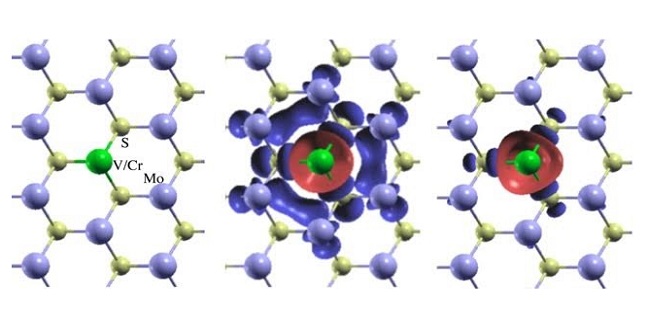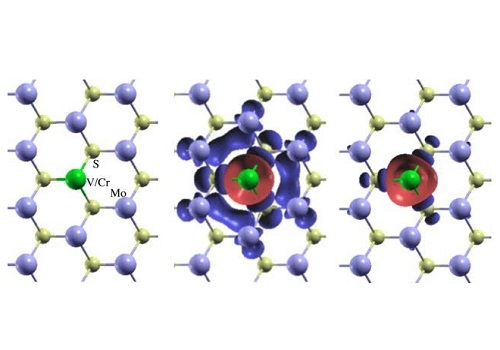Electrical Engineering
Valley polarization gets a magnetic boost
Access to valley-polarized charge carriers by magnetic doping could transform electronics.


Structure (left) and spin-density of Cr-doped (middle) and V-doped (right) single-layer MoS2.
Reproduced with permission from ref 1© 2016 John Wiley and Sons.
The field of valleytronics is emerging as a way of exploiting specific energy extrema known as valleys. This field has the potential to revolutionize conventional electronics, which rely on the control and manipulation of charged particles, such as electrons and holes, and surpass the capacity of spintronics, which depends on the intrinsic spin property of particles.
Valleytronics is based on the crucial trapping of charge carriers in energy valleys; however, device development is hindered by the complexity involved with the necessary valley polarization.
Several researchers have generated valley polarization in semiconductors called transition-metal dichalcogenides by producing an excited state through exposure to circularly polarized light. This approach, however, results in a state of nonequilibrium of dynamical valley polarization that is difficult to exploit because it demands sustained optical pumping, which requires light to pump electrons to a higher energy state.
“This problem can be eliminated by creating a permanent valley polarization by means of magnetic doping,” says Udo Schwingenschlögl, a professor of material science and engineering at KAUST.
To test this hypothesis, Schwingenschlögl and research scientist Nirpendra Singh computationally investigated the effect of magnetic doping using chromium and vanadium on valley polarization in single layers of molybdenum disulfide (MoS2). This two-dimensional transition-metal dichalcogenide comprises molybdenum atoms connected to six sulfur atoms, forming a transition metal sheet sandwiched between two sulfur sheets.
The researchers’ first option for a magnetic dopant was chromium, which presents the same electronic configuration as molybdenum. They chose this dopant thinking it might induce spin polarization—a state in which all spins are oriented in the same direction—and promote valley polarization. But, instead of the desired effect, the team observed a complex magnetic structure (see image).
According to Schwingenschlögl this surprising extended-moment formation counteracts the valley polarization. “We had to adapt to this situation, and eventually we were able to exploit it,” he adds. Consequently, the team experimented with vanadium-doped single-layer MoS2 to find that the resulting material exhibited permanent valley polarization.
Schwingenschlögl remarked that based on their physical and chemical understanding prior to these investigations, they never would have anticipated that vanadium doping would have had this outcome.
Schwingenschlögl believes that although this field remains in the realm of fundamental research, in the future, valley-polarized materials may be used to complement or surpass charge- and spin-based semiconductor technologies. The team plans to investigate in detail the effect of external electric fields on valley polarization.
References
- Singh, N. & Schwingenschlögl, U. A route to permanent valley polarization in monolayer MoS2. Advanced Materials 29,1600970 (2017).| article
You might also like

Bioengineering
Sensing stress to keep plants safe

Computer Science
Sweat-sniffing sensor could make workouts smarter

Electrical Engineering
New tech detects dehydration by touching a screen

Electrical Engineering
A new interface for efficient electronics

Electrical Engineering
Artificial neurons enable neuromorphic computing with light

Electrical Engineering
Narrow-linewidth lasers bring low-noise answer

Electrical Engineering
Octopus suckers inspire sticky medical patch

Electrical Engineering



